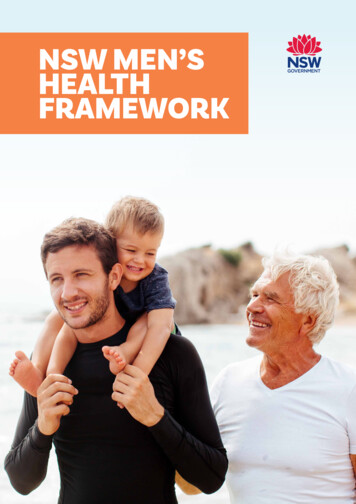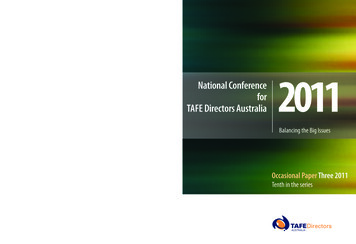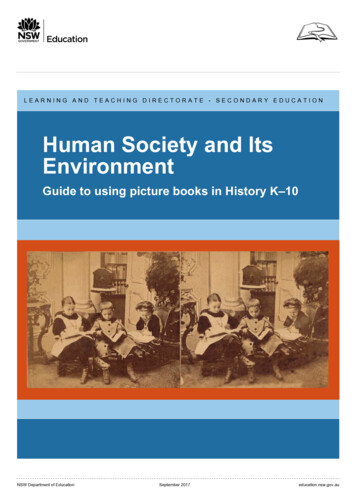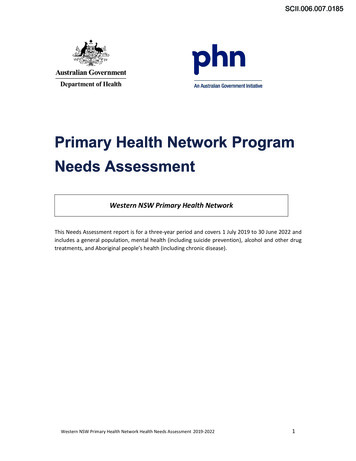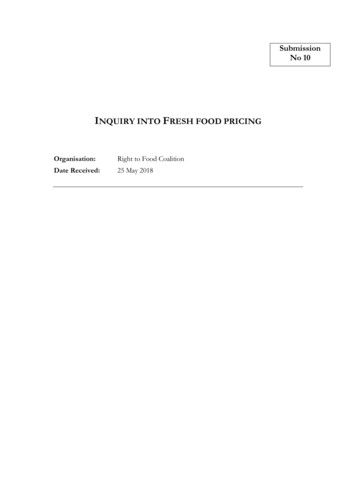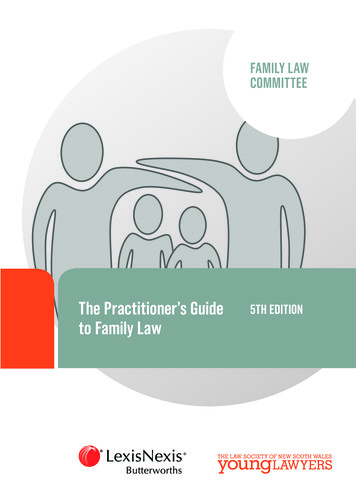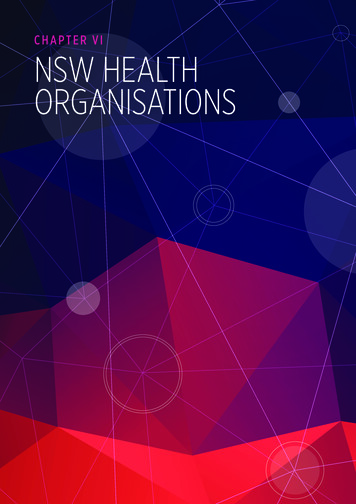
Transcription
CHAPTER VINSW HEALTHORGANISATIONSNSW HEALTH Annual Report 2016–17 Health Organisations175
NSW MINISTRY OF HEALTH73 Miller StreetLocked Mail Bag 961North Sydney NSW 2059Telephone: 9391 9000Facsimile: 9391 9101Website: www.health.nsw.gov.auBusiness hours: 9am-5pm, Monday to FridaySelected achievements for 2016-17 Progress continued on the biggest transformationand investment of regional infrastructure in NSWAmbulance history, the 122 million RegionalAmbulance Infrastructure Reconfiguration Program,which was building or upgrading 22 stations acrossthe State 1.47 billion spent on capital works in 2016-17 Health Infrastructure’s Asset Refurbishment andReplacement Program provided more than 80million to more than 500 projects, delivering criticalrepairs and maintenance 91.7 per cent of patients were transferred fromambulance to emergency department within thetarget of 30 minutes, exceeding the target of90 per cent Public dental services expanded, with 360,000people receiving care The inaugural NSW Ambulance Staff Wellbeing andResilience Summit resulted in a 30 milliongovernment investment in the protection ofparamedics and staff The Housing for Health program deliveredmaintenance services at 497 houses in 13 Aboriginalcommunities 48.6 million was allocated to support 15independent research institutes under the MedicalResearch Support Program More than 2200 people used mental health supportservices provided at the three LikeMind sites atPenrith, Seven Hills and Orange A record 47,282 full-time equivalent nurses andmidwives were working in NSW Health hospitals andhealth services as at June 2017. At the same time,there were over 11,705 full-time equivalent doctorsemployed within the NSW health system,representing about 10 per cent of the total healthworkforce 198 Enrolled Nurse scholarships were awarded, withabout one third of scholarships offered in rural areas 70 nursing and midwifery students were enrolled inthe Aboriginal Cadetship program during the year,and 133 have completed the program The Productive Mental Health Ward program wasimplemented by 24 mental health inpatient units,pursuing productivity and efficiency savings toallow frontline nursing staff to provide more directcare for patients176NSW HEALTH Annual Report 2016–17 Health Organisations Vaccination coverage for all children at one yearof age improved from 93% to 93.6% 83% of schools joined the Live Life Well @ Schoolscheme promoting physical activity and healthyeating About 1200 people from 50 teams participated inthe NSW Aboriginal Knockout Health Challenge, heldfor the first time in a custodial setting in partnershipwith Corrective Services NSW and the NSW RugbyLeague to reduce chronic disease in Aboriginalcommunities 39 Aboriginal Dental Assistants graduated in 2016,under a 1 million four-year program to provide 96traineeships NSW Health developed its focus on self-managedlearning by launching the statewide e-learningmanagement system My Health Learning, includingmore than 100 new modules and courses on topicsincluding refugee health, identifying homelessness,building a safe workplace culture and clinical care ofpeople who may be suicidal. Five modules receivednational and international awards celebratingexcellence in contemporary education design Stage two of the Electronic Medical Record projectwas live at 147 NSW hospitals by the end of the year NSW Health achieved an Aboriginal workforceparticipation rate of 2.5% The Last Days of Life Toolkit was published tosupport clinicians caring for dying patients in healthfacilities More than 500 more people with severe mentalillness were being supported to live in the communitythrough the statewide Community Living Supportsprogram 21 million was allocated to support an evidencebased approach to medical cannabis, includingresearch into cannabis medicines for people withcancer, epilepsy and multiple sclerosis Community consultations were held across NSW toinform the development of the new State plan forpalliative care 3.74 million was allocated for 17 NSW HealthEarly-Mid Career Fellowships to support and retainexperienced NSW researchers The first round of NSW Health PhD Scholarshipsprogram supported 26 applicants 9.2 million was invested in six innovative medicaldevice technologies in skin regeneration, cancertreatment and hearing diagnostics 58 (of 380) long stay psychiatric patients weretransitioned to the community More than 200 NSW Health Pathology collectioncentres open in public hospitals and communityhealth centres 194 sites were connected to the Health Wide AreaNetwork
STATUTORY HEALTH CORPORATIONSNSW AGENCY FOR CLINICAL INNOVATIONLevel 4, 67 Albert AvenueChatswood NSW 2067PO Box 699Chatswood NSW 2057Telephone: 9464 4666Facsimile: 9464 4728Website: www.aci.health.nsw.gov.auBusiness hours: 8am-5pm, Monday to FridayYear in reviewThe NSW Agency for Clinical Innovation workedthroughout the year with clinicians, consumers andmanagers to design and implement innovation projectsacross the health system.Key activities included establishing the NSW DiabetesTaskforce, expanding the NSW pilot of the AmericanCollege of Surgeons National Surgical QualityImprovement Program (ACS NSQIP), andimplementing the Intensive Care Service Model for thesafe and efficient delivery of care to critically ill patientsin smaller rural and metropolitan intensive care units.We worked to improve patient and carer satisfactionwith key health services and built strong engagementwith communities through a number of programs.These included the One Deadly Step Aboriginal chronicdisease screening program, the Music and Memoryprogram, the Living Well in Multipurpose ServiceCollaborative, and developing The Essentials, aresource to support local health districts deliveringhealth services for people with intellectual disability.We continued to build digital services and enablee-health strategies through developing the NSWTrauma App, which provided lifesaving informationfor trauma clinicians during emergencies. We alsoembedded telehealth as a mechanism to deliverhealth care by connecting clinicians to patients andcaregivers for assessment, intervention, consultationand/or supervision.Our commitment to providing a truly integrated healthsystem was strengthened the development of theNavigating the Healthcare Neighbourhood website,which explored the patient-centred medical homemodel, and through the Patient Reported Measuresprogram proof of concept, which was implemented in81 health services across NSW.A key focus in 2016-17 was to become more agile andresponsive to the needs of stakeholders. We strengthenedpartnerships with local health districts, including QualityImprovement Partnerships with 13 local health districtsto support quality improvement in stroke care, andjoined with 19 facilities to investigate clinical variationin acute care for people with chronic obstructivepulmonary disease and/or chronic heart failure.We recognised the importance of our staff anddemonstrated this commitment through theProfessional Development Framework, andby investing in technology to improve mobilityand flexibility.Jean-Frédéric Levesque, Acting Chief ExecutiveDr Levesque has been the Acting Chief Executive sinceJune 2017. He had been chief executive at the Bureauof Health Information from March 2013. Before comingto Australia, Dr Levesque held senior positionsresponsible for publicly reporting information about theCanadian health system. He has a Doctorate in PublicHealth, a Master’s in Community Health and a medicaldegree from the University of Montreal, Canada.Within the reporting period, Dr Nigel Lyons held theposition until October 2016. Professor Donald MacLellanwas appointed in an acting capacity from October untilhis retirement in June 2017.79% of NSW Trauma App userssaid it contributed to positivepatient outcomesKey achievements for 2016-17 Established the NSW Diabetes Taskforce to developa system-wide response to improve the care ofpeople with diabetes. This was a partnershipbetween the Agency’s Chronic Care and Endocrinenetworks. Developed The Essentials, a resource and websitedesigned to guide local health districts to deliverhealth services for people with intellectual disability.The Essentials provided useful information, tools,interviews, videos, references and external links. Launched the Navigating the Health CareNeighbourhood website, exploring the patientcentred medical home model and expanding on therole of the health care neighbourhood in supportingthe model. An online community of interest started inJune 2017. Supported local teams to implement the IntensiveCare Service Model, a framework for the safe andefficient delivery of care to critically ill patients insmaller rural and metropolitan intensive care units. Completed the Trauma Patient Outcome EvaluationQualitative Report, which focused on resourcing theNSW Trauma Services, including paediatric services. Implemented the Patient Reported Measuresprogram proof of concept in 81 health services acrossNSW. This resulted in 974 completed PatientReported Outcome Measures and 652 completedPatient Reported Experience Measures.NSW HEALTH Annual Report 2016–17 Health Organisations177
Designed the Living Well in Multipurpose ServiceCollaborative to support staff to provide care forresidents of 25 Multipurpose Services. The residentswere cared for in the context of living in their ownhome, rather than as patients in hospital. Completed a workplace strategy to accommodategrowth and improve technology for more mobile andcollaborative ways of working. The strategy was alsoto assist with testing an agile work environment inpreparation for the Agency’s move to a new sharedworkplace at St Leonards in late 2019. Developed the Agency’s Aboriginal EmploymentStrategy 2016-18. The key priorities of the strategywere to attract and retain Aboriginal staff, supportcareer development and progression, and improvecultural competency in the workplace.BUREAU OF HEALTH INFORMATION67 Albert AvenueChatswood 2057Telephone: 9464 4444Facsimile: 9464 4445Website: www.bhi.nsw.gov.auBusiness hours: 9am-5pm, Monday to FridayYear in reviewThe Bureau of Health Information continued in its roleof providing independent reports on the performanceof the NSW public health system to the NSWGovernment, the community and health careprofessionals. Reporting focused on accessibility,appropriateness, effectiveness, efficiency, equity andsustainability.In the 2016-17 year, we published 13 reports with afocus on two new patient groups: Aboriginal patientsand maternity patients. The Bureau provided in depthinformation about the self-reported experiences ofcare these patients received as admitted patients, andthroughout the maternity journey.This year we also began publishing activity andperformance data on ambulance services in NSW. Thisinformation was incorporated into a regular reportingseries, Healthcare Quarterly.We published several reports, a summary report andhospital-level profiles with updated information onmortality and re-admissions. In the months prior topublication, we engaged extensively with clinicians andlocal health districts to test findings in differentcontexts, respond to local feedback and ensure theinformation presented was meaningful and actionableat a hospital level.To ensure global best practice in measurement andreporting was maintained, we continued to participatein international and national meetings and publish workin peer reviewed literature.Our team introduced innovations to the Bureau’swebsite, which was updated to provide information in arange of formats to suit different audiences. Thevariety of materials available on the website includedvideos, animations, profiles for hospitals and localhealth districts, interactive data to suit basic andadvanced users, blogs and infographics.178NSW HEALTH Annual Report 2016–17 Health OrganisationsWe continued to manage the NSW Patient SurveyProgram to support the integration of patient feedbackinto health system improvements. Each monththousands of people were surveyed about their recentexperiences of care in a NSW public hospital. The datawas made publicly available on our online data portalHealthcare Observer, and in many published reports.In May 2017, the Chief Executive, Dr Jean-FrédéricLevesque, accepted a secondment to the Agency forClinical Innovation. I would like to acknowledge theleadership and support that Dr Levesque provided tothe Bureau during this year, and since his arrival in 2013.Kim Sutherland, Acting Chief ExecutiveDr Sutherland was appointed Acting Chief Executive ofthe Bureau in May 2017. Her substantive position at theBureau is Senior Director, Performance Measurementand Reporting. Dr Sutherland is a health servicesresearcher who has played a central role in thedevelopment of performance measurementframeworks in health care systems in the UnitedKingdom and in NSW. She was co-author on a series ofreports evaluating the NHS 10-year quality agenda andthis work continues to act as the conceptual base forthe joint Health Foundation – Nuffield TrustQualityWatch initiative, based in London. Dr Sutherlandsits on a health care quality indicator technical advisorygroup of the OECD. She has a Bachelor of Sciencedegree from the University of Technology, Sydney; aMaster of Science from London Hospital MedicalCollege; a Master of Business Administration fromImperial College, London; and a Doctorate from theUniversity of Cambridge.Published 13 reports withinformation to assist cliniciansand managers to improvehealth care servicesKey achievements 2016-17 The Bureau published an updated suite of reportsexploring unwarranted clinical variation in patientoutcome measures across NSW public hospitals –looking at mortality following hospitalisation andre-admission to hospital across nine conditions.These reports provided hospitals with clear andactionable performance information. Published four Hospital/Healthcare Quarterly reportsfeaturing information about activity and performancein NSW public hospitals and ambulance services, andinteractive data at hospital, district/zone, peer groupand NSW levels. Collaborated with the Cancer Institute NSW topublish a Patient Perspectives report about theexperiences of more than 3700 people whoattended an outpatient cancer clinic. This reportcontained the first systematic information on patientself-efficacy and an assessment of how welltreatment-related symptoms were controlled.
Ensured transparency in the Bureau’s methods bypublishing three Spotlight on Measurement reportsoutlining technical issues relevant to measuringunwarranted clinical variation and ambulanceperformance in NSW. The Bureau surveyed thousands of adult patientsadmitted to NSW public hospitals (including smalland rural hospitals), admitted children and youngpatients, emergency department patients of rural,regional and metropolitan hospitals, maternitypatients and patients attending outpatient clinicson their health care experiences . This informationwas provided to local health districts and hospitalsto better inform efforts to improve the patientexperience. Increased the data available on the Bureau’s onlineportal Healthcare Observer, including new surveydata from maternity patients, adult admittedpatients, outpatients of cancer clinics andperformance data on ambulance services in NSW. Developed innovations on the Bureau website toprovide information in different formats so thatdifferent audiences could access content in wayssuited to their needs. Hosted two research fellows from the United Statesand Canada who participated in Bureau projects,built expertise related to predictive risk modelling inthe organisation, and contributed to other areas ofresearch in health system performance.CANCER INSTITUTE NSWLevel 98 Central AvenueAustralian Technology ParkEveleigh NSW 2015PO Box 41Alexandria NSW 1435Telephone: 8374 5600Website: cancerinstitute.org.auBusiness hours: 9am-5pm, Monday to FridayYear in reviewCancer remained one of the biggest causes ofpremature death in our community. While the numberof people in NSW diagnosed with cancer was steadilyrising, advances in prevention, early detection,diagnosis and treatment allowed many more people tosurvive and live longer with the disease.The Cancer Institute NSW provided the strategicdirection for cancer control across the state, driven bythe goals of the NSW Cancer Plan:Although the burden of cancer was shared by all, itseffects were not distributed equally across the NSWpopulation. Some groups were more affected bycancer than others, including Aboriginal people, peoplefrom culturally and linguistically diverse backgrounds,and people from rural and remote and lower socioeconomic backgrounds.We continued to focus on improving outcomes forthese communities and ensuring people diagnosedwith cancer across NSW received the right treatment,in the right place, at the right time.This year, the Institute launched its first InnovateReconciliation Action Plan, endorsed by ReconciliationAustralia – a practical plan of action reinforcing thepositive work the Institute had done to build positiveand respectful relationships with Aboriginal communitiesin a culturally appropriate way. The Institute alsoformed an Aboriginal Program Development Committeein early 2017, which involved representatives fromAboriginal communities providing direct input torelated projects across the organisation.As outlined in the NSW Cancer Plan, we continued tofocus on some cancers with high incidence rates andpoorer outcomes (for example, lung and bowel), aswell as enhancing primary care involvement in cancercontrol and ensuring patient-centred quality cancercare was upheld across the State.The Institute launched the NSW Primary Care Strategyfor the bowel, breast and cervical screening programsin September 2016, with a representative advisorycommittee established to support the strategy’simplementation.We continued to support and promotemultidisciplinary cancer care teams as best practicecancer care that enhanced communication betweenspecialists, patients and their GPs.Patient experience moved to being reported as partof the Reporting for Better Cancer Outcomes program(in collaboration with the Bureau of Health Information).The 2016 statewide performance report includedidentified local health district data for the first timeand highlighted improvements and opportunities incancer control measures across the state.As the largest funder of cancer research in NSW, theInstitute managed its strategic investment on behalfof the NSW Government to build research capacity,attract and keep world-class researchers, fosterinnovation and support the translation of discoveriesinto clinical practice. Increase the survival rate of people with cancerWhile there was still much to do for people living inNSW, their chances of surviving cancer were amongthe highest in the world as we continued to lessenthe impact of cancer across the state. Improve the quality of life of people with cancer.David Currow, Chief ExecutiveWe continued to collaborate with local health districts,primary health networks, the NSW Ministry of Health,NSW Health pillars, government and non-governmentorganisations, researchers, health professionals andthe community to develop and implement initiativesacross the full spectrum of cancer control, from cancerprevention and early detection to optimising cancertreatment and care, and facilitating research in all ofthese areas.Professor Currow is the Chief Cancer Officer of NSWand Chief Executive Officer of the Cancer InstituteNSW. Before his appointment in March 2010, ProfessorCurrow was the foundation chief executive officer ofCancer Australia. Professor Currow is a Fellow of theAustralian Academy of Health and Medical Sciences,the previous president of the Clinical OncologicalSociety of Australia and a past president of PalliativeCare Australia. He also served on the American Society Reduce the incidence of cancerNSW HEALTH Annual Report 2016–17 Health Organisations179
of Clinical Oncology working party on palliative careeducation, and chaired the working party for the Unionof International Cancer Control on Palliative Care for theUnited Nations summit on non-communicable diseases.He has also been on faculty for the Australia andAsia-Pacific Clinical Oncology Research Developmentworkshops.50% of NSW’s pathologynotifications are now beingsent electronically to theNSW Cancer RegistryKey achievements 2016-17 Six anti-tobacco mass media campaigns wereimplemented over the financial year. Adult smokingprevalence declined from 16.9 per cent in 2010 to 15per cent in 2016. The iCanQuit website was used by 711,361 peoplebetween July 2016 and June 2017. This was anincrease of about 122 per cent from the equivalentperiod the previous year (320,583 users). The NSW skin cancer prevention campaign 2016-17ran from November to March, targeting 13- to24-year-olds. The campaign prompted intentions toincrease sun protection among 58-60 per cent of thetarget audience who saw the campaign, andencouraged an increase in sun protection use ofbetween 43 and 44 per cent. Three-dimensional mammography (tomosynthesis)became available in 20 of 21 BreastScreen NSWassessment sites, with training and support providedto all assessment staff. This improved overall imagequality for women who needed further assessmentafter their initial screening mammogram. The Institute operated the Bowel ScreeningParticipant Follow Up Function (PFUF) since 1 July2016, under the National Partnership Agreement withthe Commonwealth Department of Health. PFUFofficers followed up more than 20,000 NSWNational Bowel Cancer Screening Programparticipants, minimising undue delays in bowelcancer diagnoses and participant uncertainty. Three local health districts adapted and implementedthe lung cancer diagnostic pathway, whichsupported improved diagnostic pathways and timelyaccess to best practice cancer treatment. EightDistrict grants for lung cancer diagnostic pathwaylocalisation were awarded from January to June 2017. The Patient Reported Measures (PRM) forPersonalised Treatment and Care project enabledthe collection of patient-reported measures routinelyin one District and, as part of the research program,in two other Districts. Implementation to 31 December2017 was to enable engagement with three Districtsto facilitate development of a statewide PRM solution. The Electronic Pathology Solution project wasimplemented in four laboratories (two public and twoprivate), resulting in more than 50 per cent of thestate pathology notifications of diagnoses of cancerbeing sent electronically to the NSW Cancer Registry.180NSW HEALTH Annual Report 2016–17 Health Organisations There were 418 interventional cancer clinical trialsopen for recruitment in NSW. Of these, 140 wereCancer Institute NSW portfolio trials (that is,investigator-initiated, non-commercial). During thistime 1765 participants were enrolled on theseportfolio trials. This represented a 29 per centincrease in enrolments from 2015. The seven Institute-funded translational cancerresearch centres brought together 787 membersfrom 73 institutions actively involved in flagshipprojects in 2016.CLINICAL EXCELLENCE COMMISSIONLevel 17, 2-24 Rawson PlaceHaymarket NSW 2000Locked Bag 8Haymarket 1240Telephone: 02 9269 5500Facsimile: 02 9269 5599Website: www.cec.health.nsw.gov.auBusiness hours: 8:30am-5pm, Monday to FridayYear in reviewThe Clinical Excellence Commission collaborated withthe Cancer Institute NSW to present the final report ofthe inquiry into Off-protocol prescribing ofchemotherapy for head and neck cancers. The reportwas given to the Secretary of NSW Health on 31 July2016. As well as contributing to the report in general,we contributed specifically by interviewing 26 patientsand/or their families affected by the issue.In line with the core incident management andgovernance function, we worked closely with aninvestigation that followed the discovery an oxygenoutlet in the Bankstown Hospital operating theatreswas producing nitrous oxide instead of oxygen. Wealso helped co-ordinate checks of medical gas outletsacross NSW.In September 2016, the APAC Forum was presented byAuckland’s Ko Awatea innovation centre, with theClinical Excellence Commission and the Agency forClinical Innovation as headline sponsors. Theinternational health improvement conference, themedExploring New Frontiers, attracted over 1500 leadersfrom more than 30 countries to Sydney.Throughout the year, we collaborated with the Officeof the Chief Health Officer, Chief Pharmacist Unit,HealthShare NSW and the CEC AntimicrobialStewardship Expert Advisory Committee to developcommunications regarding antibiotic shortages.We also worked with the Office of the Chief HealthOfficer, local health districts and clinicians to provideresources and advice about the potential infection ofcardiac surgery patients with Mycobacterium chimaerabacteria associated with contaminated heater-coolerdevices. Four cases were confirmed in Australia.In 2017, we established an improvement partnershipwith Women’s and Children’s Healthcare Australasia.
The NSW Chief Psychiatrist and I held a series ofregional workshops with frontline staff to identify keypriorities for the NSW Mental Health Patient SafetyProgram, starting later in 2017. These workshopsfollowed an initial statewide meeting held withdirectors of Mental Health Services to discuss improvedcare of mental health patients.Carrie Marr, Chief ExecutiveBefore her appointment as Chief Executive in October2015, Ms Marr was the executive director, organisationeffectiveness at Western Sydney Local Health District.She earlier held a number of leading executive andconsultant positions in the United Kingdom for a varietyof organisations including the National Health Service,Scotland. She is a graduate of the renowned advancedtraining program in Quality Improvement atIntermountain Health Care, Utah, USA and also holds aBachelor of Science (Nursing), a Diploma in Education(Nurse Teaching) and a Master of Science (OrganisationConsulting).More than 10,000 monthlyquality audits were completedby NSW health staffKey achievements 2016-17 The Clinical Excellence Commission QualityImprovement Academy was established to providelearning opportunities for Health staff. The Last Days of Life Toolkit was published toprovide tools and resources to ensure the best carefor all dying patients. Key areas of focus includedidentifying all dying patients early so they couldreceive optimal symptom control and have social,spiritual and cultural needs addressed. Involvingpatients and their families in decision-making andbereavement support were also identified as focusareas. In collaboration with NSW Government andinternational partners, the Commission held thesecond Academy for Emerging Leaders in PatientSafety, based on the Telluride model. The four-dayforum was attended by 30 emerging leaders fromacross Australia. Across the year, 10 Safety Alerts/Notices and nineMedication Shortage Communications weredeveloped in response to a range of medicationshortages to minimise medication safety risks. The article Sepsis kills: early intervention saves lives,written by Commission staff and published in theMedical Journal of Australia, was awarded the 2016MJA/MDA National Prize for Excellence in MedicalResearch. This year the Organisational Safety ImprovementMatrix was introduced to generate shared prioritiesfor building local capability for improvement. The Commission developed a NSW MaternityVenous Thromboembolism risk assessment tool anddeveloped supporting resources to help preventblood clots in pregnant and post-partum women. In September 2016 the Commission published theClinician’s Guide to Quality and Safety, targetingfrontline clinicians starting in quality and safetyimprovement. More than 1500 staff participated in structuredtraining programs on quality improvement toolsthroughout the year, as part of the offering from theQuality Improvement Academy. The Commission co-hosted the 2017 PatientExperience Symposium, bringing together more than550 NSW health staff, consumers and consumergroups from within the health system.HEALTH EDUCATION ANDTRAINING INSTITUTEBuilding 12, Gladesville HospitalShea CloseGladesville NSW 2111Locked Bag 5022Gladesville NSW 1675Telephone: 9844 6551Facsimile: 9844 6544Website: www.heti.nsw.gov.auBusiness hours: 8:30am-5pm, Monday to FridayYear in reviewExcellence and innovation in education and trainingfor the NSW Health workforce were the focus for theHealth Education and Training Institute in 2016-17.In late October 2016, the Institute was awardedregistration as a Higher Education Provider through theTertiary Education Qualifications and StandardsAgency. Full accreditation was granted for the Instituteas an entity and for its two submitted mental healthframeworks: Psychiatric Medicine and Applied MentalHealth Studies. These recovery-oriented programs,which started in 2017, were designed to meet the needsof health professionals across the state and beyond. InJanuary 2017 the transition of the former NSW Instituteof Psychiatry to the Institute as a dedicated mentalhealth portfolio was completed.A record 992 junior medical officers were placed intoNSW Health hospitals in 2017. Five new posts for theNSW Rural Generalist Medical Training Program werefunded, bringing the total to 40 in rural NSW.With a renewed focus on self-managed learning, thestatewide e-learning management system, formerlyknown as HETI Online, was reintroduced as My HealthLearning. The Institute developed 115 new e-learningmodules and courses for My Health Learning coveringtopics including refugee health, identifying homelessness,building a safe workplace culture and clinical care ofpeople who may be suicidal. Five e-learning modulesreceived national and international awards celebratingexcellence in contemporary educat
Penrith, Seven Hills and Orange A record 47,282 full-time equivalent nurses and midwives were working in NSW Health hospitals and health services as at June 2017. At the same time, there were over 11,705 full-time equivalent doctors employed within the NSW health system, representing about 10 per cent of the total health workforce


